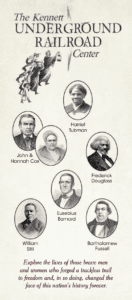
By Steven Hoffman Chester County PRESS
Antebellum Kennett Square played an important role in the Underground Railroad, the network of meeting places, secret routes and safe houses that were used by slaves to escape into free states and Canada in the early- to mid-1800s. The slaves were often helped along their journey by abolitionists and allies who were sympathetic to their cause and would provide them with the shelter, food, and money that they would need until they could move on to the next stop. The Underground Railroad relied on both white and black abolitionists, religious communities, and other groups to help slaves on the path to freedom. Conductors guided fugitives to safe houses known as stations. Escaped slaves would move along the route from one station to the next, steadily making the way north. There were dozens of Underground Railroad stations within an eight-mile radius of Kennett Square—possibly one of the largest concentration of underground railroad stations in the nation—making Kennett Square a hotbed of abolitionist activity.
The Kennett Underground Railroad Center (KURC) was formed in 1998. Their mission is to preserve that heritage and engage the public about historic abolitionists and freedom seekers of this area and beyond. Members of the Kennett Underground Railroad Center work to identify buildings recognized as stations on the Underground Railroad, and encourage and assist the owners to have these home recognized on a local, state, or national level. Members also organize tours, take part in public-speaking activities, and publish works that aim to educate people about the unique local heritage.
According to Michele Sullivan, a board member of the Kennett Underground Railroad Center (KURC) and committee member Loraine Lucas, the true extent of Kennett Square's role in the larger Underground Railroad is not well known to most people, even among local residents and descendants of those who actively participated. That’s why educating the public, both local residents and visitors, is such an important part of the mission.
Why was Kennett Square such a hotbed for abolitionist activity? There are a number of reasons, starting with its location. Pennsylvania was a free state, and many escaped slaves from Delaware, Maryland, and Virginia fled here on their way to the north. Some of the most important stations along the secretive Underground Railroad were strategically located in Pennsylvania and Delaware. Some of the farmhouses in the area had secret hideaways where slaves could be concealed during the day, and then moved on to the next station during the night. The border between Pennsylvania and Maryland has been described as the “fissure point” between free and slave states. Fugitive slaves reaching underground stations in Pennsylvania were in great peril, but they were also that much closer to freedom.
Check out the KENNETT UNDERGROUND RAILROAD BROCHURE
